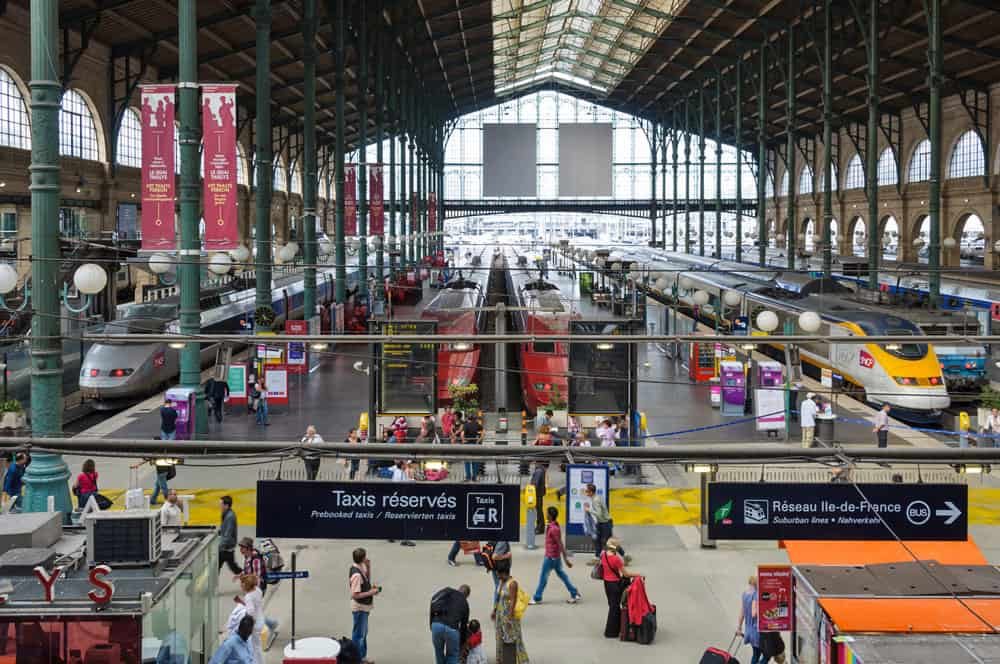
It doesn’t get much better than zooming through the French countryside at 200mph. In fact, when it comes to train travel, France is one of the best-connected countries in Europe and you can easily reach many of Europe’s great cities from Paris.
But, like all things French, their rail network can be a little confusing so I’m here to help. In this France Train Guide, I’ll tell you everything you need to know about traveling around France by train—from navigating the system to buying train tickets for the cheapest price.
How To Buy Train Tickets in France

Buying French train tickets is generally easy but you may experience a few quirks when booking—keep reading and we’ll walk you through the process.
Let’s first look at where and when to buy tickets to get the best prices…
Quick Note On Electronic Train Tickets And Reliable Mobile Data
Most train tickets in France (and Europe) are electronic so having reliable high-speed data for your phone is important—luckily, getting high-speed data in France is simple and affordable. Here are a few articles I’ve written to help you get set up:
Where To Buy Train Tickets For French Trains
So there are a handful of websites/methods for buying French train tickets.
Let’s take a look at the various options:
Omio
Omio is a search engine that lets you compare and book trains anywhere in Europe. It lets you easily book tickets with your credit card at essentially the same prices as France’s Railways website.
Additionally, Omio searches routes for multiple rail services across Europe so it’s great for international trips (since it can easily combine rail journeys of multiple countries). They have a nice Smartphone App that organizes all your electronic train tickets.
TrainLine
TrainLine is another third-party booking site that connects directly to the French National Rail Network and other European networks. Trainline also accepts international credit card payments and keeps all your eTickets organized on their Tranline App.
SNCF (National French Railways)
The website for the official French Railways is en.oui.sncf. The main problem with this site is that it often tries to redirect you to RailEurope.com—which is SNCF’s official North American partner. Unfortunately, Rail Europe rarely finds the cheapest fares so you have to actively try to keep the site from redirecting you. And trying to book through the official SNCF website can be equally as difficult because it can be plagued with translation issues and sometimes they reject foreign credit cards.
Perosanlly, I’d stick with Omio.
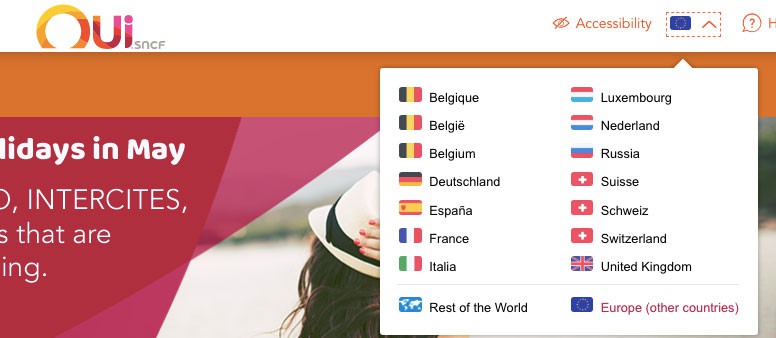
Ouigo
A few years ago the French National Railways created a new low-budget train line called Ouigo. It basically connects Paris with a handful of popular French destinations.
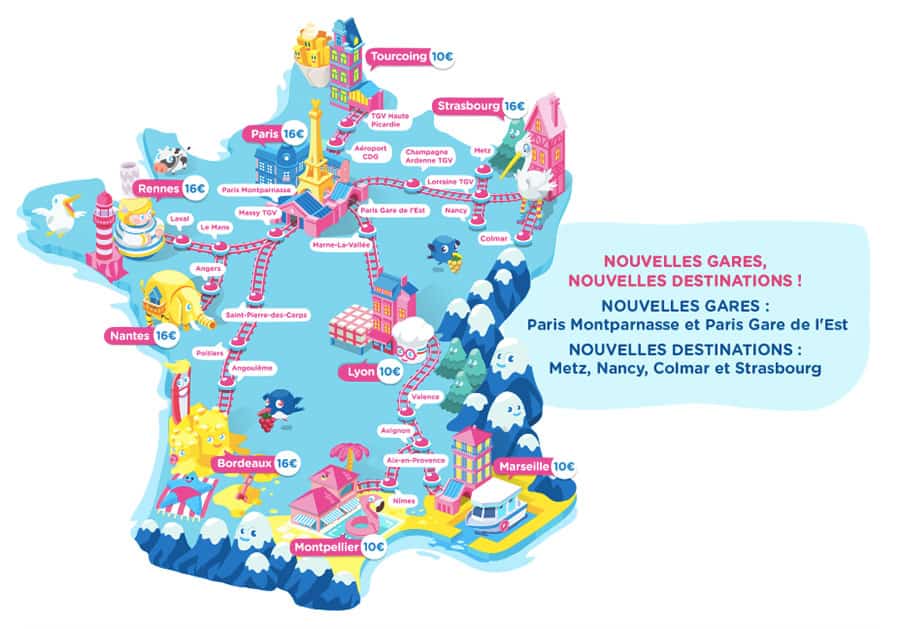
Some Ouigo trains leave from stations outside Paris so it takes a little under an hour by regional train to get there from central Paris. However, some trains do leave from central Paris. There are a few other restrictions (like limited luggage) but the fares can be crazy cheap. Booking websites like Omio will include Ouigo in their results so you don’t have to search Ouigo’s website to find/buy its tickets.
Eurostar
The Eurostar is the train that connects Paris and London. You can usually book this journey on other websites but we’ve found it best to book directly from the Eurostar site for the best prices.
At The Train Station
Of course, you can buy any French train ticket from any train station — either from a ticket window or an automated machine (you’ll need a Chip & PIN credit card to buy from the machines). You can buy tickets in advance from train stations as well.
HOW TO COLLECT YOUR FRENCH TRAIN TICKETS
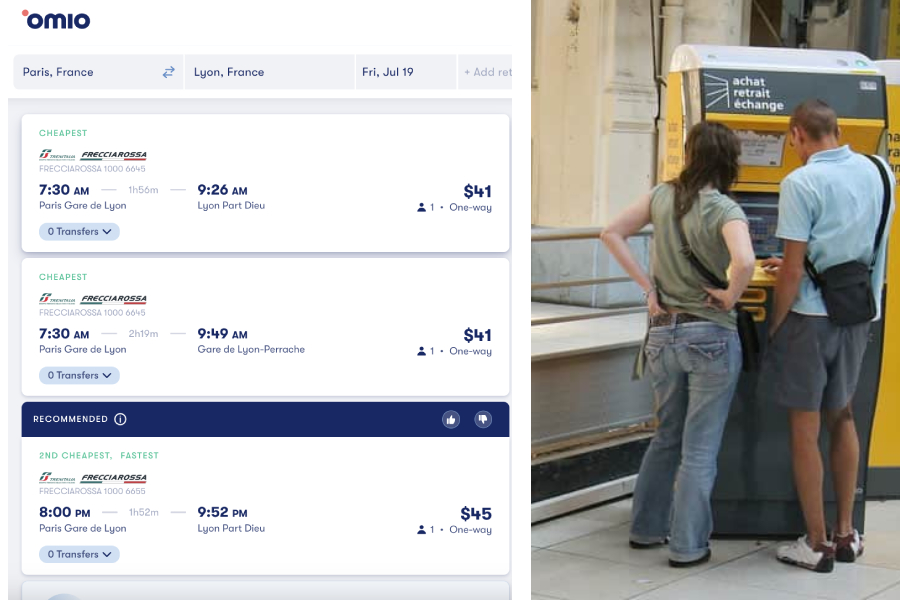
Tickets purchased online can be collected in a few different ways. Most times you’re given multiple methods of collecting your tickets:
- Electronic Tickets: Almost all French train tickets are now electronic—for example, tickets bought via Omio will be sent to your Omio app. You can also have tickets sent to your email. You simply show your tickets to the train’s conductor when they check your tickets.
- Pick Up At Station: Use your credit card or a booking confirmation number to collect your tickets at the train station. You’re often required to use the same credit card used to purchase the tickets to collect them up at the station—so keep this in mind when booking.
- Mailed Tickets: Some services will mail you physical tickets but this is often a slow process. We suggest avoiding this and sticking to the other options.
Do You Need To Buy French Train Tickets In Advance?
France has a number of different train services so it can be a little confusing to know what tickets should be purchased early and which can be bought whenever.
I’ve broken it all down below:
High-Speed TGV Trains [Buy Early As Possible]

Book high-speed trains in France as early as possible. Tickets for France’s TGV high-speed trains are available to purchase around 90 days in advance. Booking these early will get you the cheapest tickets because prices generally continue to rise as the departure date approaches. For example, a day-of ticket can cost well over €100 but the same ticket bought weeks early might only cost €30.
International Trains [Buy Early As Possible]

There are a few separate train services that connect France to other countries. These are high-speed trains so the same rules about booking early apply to these tickets as well:
- TGV Lyria: High-speed trains that connect France and Switzerland.
- THALYS: High-speed trains that connect Paris with Belgium, Germany and the Netherlands.
- Inter-City Express (ICE): High-speed trains that connect France and Germany.
- Eurostar: High-speed trains that connect Paris and London.
Intercité Trains (IC) [Buy A Little Early]

Intercité trains are fast trains but not as quick as the TGV trains. They usually also connect shorter distances and the trains aren’t quite as nice as the TGV. These tickets can also be purchased in advance for a discount.
Regional/Local Trains [Buy Whenever]

France has a number of slow trains that connect suburban and regional areas. TER (regional trains that connect smaller towns with regional hubs), Transilien (connects suburban Paris), and RER (also connects suburban Paris). These tickets are priced by distance traveled so you don’t need to buy them in advance—simply purchase them at the station right before departure.
Don’t forget to validate your ticket before you get on the train or you’ll be fined.
How To Use Your French Train Tickets
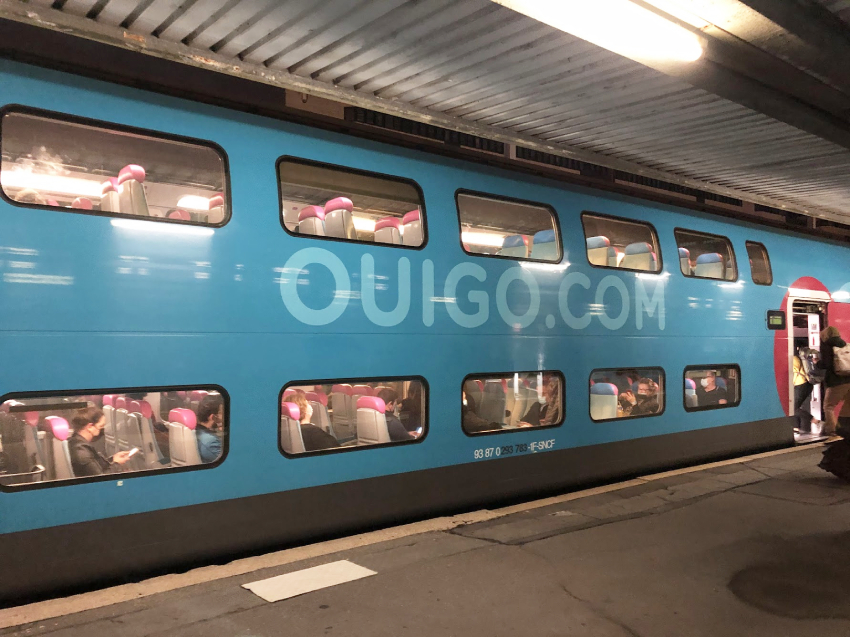
On high-speed trains, your ticket is only good for the specific time stated on your ticket. You’ll also be given an assigned seat.
You don’t need to validate your ticket because your seat is reserved (but they might check your ID on the train).
NOTE: Your ticket will show the car and seat number so make sure you’re in the right car (the trains are clearly marked).
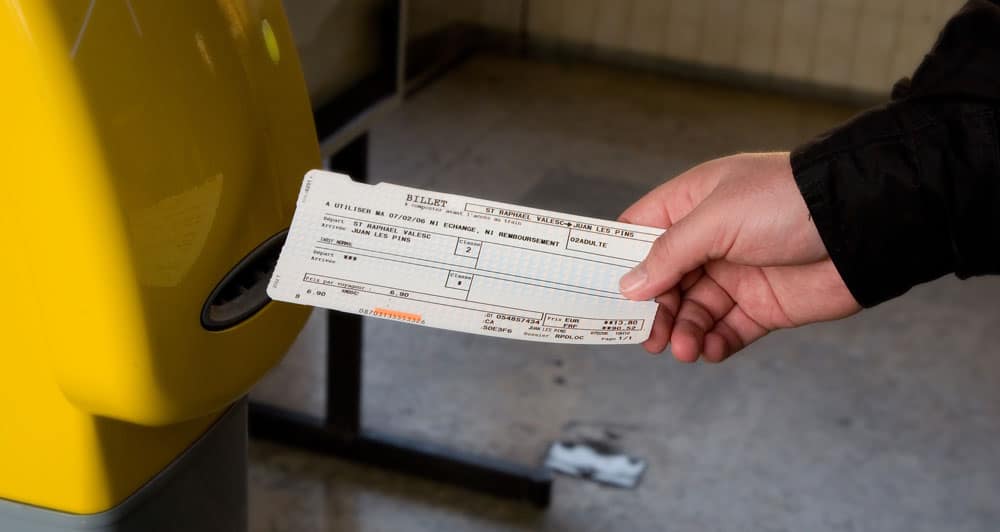
On regional/local trains, you might have a physical ticket. Make sure to validate (i.e. stamp) your ticket in the validation boxes on the platform before you get on the train. They’re sometimes hard to find so watch what the locals are doing. If you forget to validate, seek out the train’s conductor quickly and have him/her stamp it—if you wait until they come around you might be given a fine.
Regional trains won’t have seat reservations so you can sit anywhere.
Once you’re on the train the conductor will eventually walk through the aisles to check tickets.
HOW TO MAKE RAIL PASS RESERVATIONS
High-speed trains require you to make a reservation when using a Eurail pass — the reservation costs €10-€30/seat for domestic travel and international trains can charge anywhere from €35-€89/seat (depending on destination). As you can see, those international train reservations can be wildly expensive—in fact, the reservation fee is often more expensive than buying a separate ticket.
You must make the reservation before you get on the train. There are a few ways to make reservations:

- Make Reservations Online: Omio lets you book your reservation online through their platform. Simply look for a button that says “I Have A Railpass” and follow the prompts.
- Make Reservations At The Train Station: You can simply go to the train station and book your reservation from the customer service desk or self-service kiosks. You can book it weeks in advance or you can do it the day you depart. We suggest using the kiosks because the ticket window can take forever.
More Tips For Riding Trains In France
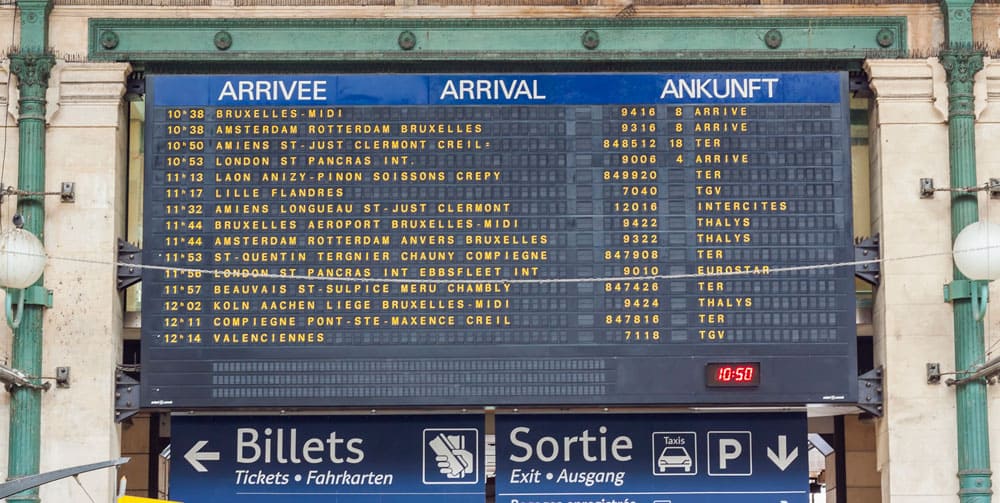
Here are a few general tips about train travel in France.
Get To The Train Station A Little Early
Train stations are usually fairly easy to navigate but they can be a little confusing. There isn’t any security that you have to go through (except for Eurostar and THALYS trains) so there is no reason to arrive an hour before your departure but it doesn’t hurt to arrive about 20-30 minutes early if you’re not familiar with the station.
Stations can also be larger than you might expect so you could need to do a bit of walking to find your platform.
Study The Departures Board
The most confusing part of train travel is finding your train’s departure platform.
First, find your train number on your ticket.
Next, study the departure board until you see your train number. The board will show you which platform your train is leaving from—don’t worry if there is no platform listed yet because they often only display the platform for trains departing within the next 10-20 minutes.
However, do pay attention as sometimes the platform can change at the last minute.
Know Train Station Names
Most large cities have multiple train stations (Paris has seven) so this often creates confusion. Double-check that you have the right station—especially when booking your ticket.
Self-Service Machines Are In English
Don’t worry if you don’t speak French because the ticket machines (and train station signs) are all in English. Most customer service workers also speak some English.
Cheap Tickets Are Non-Refundable
One downside to cheap tickets is that they’re non-refundable and can’t be changed.
Pack A Picnic
You’re allowed to bring your own food and alcohol on trains. It’s great for those long train rides.
No Luggage Restrictions
There aren’t any weight limits on luggage and you can bring as much as you want (well, as much as you can carry). Simply bring it on and store it above your head, behind your seat, or in the luggage racks in each car.
Making Connections
Your rail journey might require you to change trains along the route. Don’t worry if there are only a few minutes between trains because switching trains is usually fairly quick and easy—it’s not like flying where you need an hour-long layover.
First Class vs Second Class Tickets
First Class tickets normally cost 1.5x the Second Class rate. Second Class is perfectly comfortable but First Class seats are a bit bigger and it’s quieter. Other than that, there isn’t much more of a difference.
Rail Strikes
France is well-known for train strikes. They always give ample warning before going on strike and they still run some trains, but it’s something to pay attention to.
Read More Of My Articles On Budget Travel in France

- Paris Travel Guide: Tips For Visiting Paris
- How To Choose The Best Travel Insurance: Travel insurance will help cover those non-refundable train tickets if something goes wrong during your trip.
- Packing List For Europe Travel: Tips on packing light (which makes train travel much easier).
- The Best eSIM Data Plans For France: My guide to the cheapest prepaid eSIM data plans for your trip to France.
- Guide To Using Smartphones, SIM Cards, and Data Plans In Europe - August 2, 2025
- Backpacking Europe Packing List — My Europe Travel Packing Guide - July 26, 2025
- The Best Travel Backpacks | In-Depth Buyer’s Guide & Backpack Reviews - July 5, 2025

No Funny Business
The Savvy Backpacker is reader-supported. That means when you buy products/services through links on the site, I may earn an affiliate commission—it doesn’t cost you anything extra and it helps support the site.
Thanks For Reading! — James
Questions? Learn more about our Strict Advertising Policy and How To Support Us.





